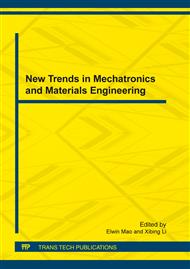p.240
p.245
p.250
p.255
p.260
p.266
p.271
p.275
p.281
Preparation and Electrochemical Properties of TiN-Nickel-Graphite Composite Anode Materials for Lithium Batteries
Abstract:
The purpose of this study was to research the effect of tin-nickel alloy plating solution temperature, the dosage of graphite powder on the structure and composition of tin-nickel –graphite composite materials prepared by electrodeposition, discuss the relationship between carbon content and the specific capacity composite plating, charge and discharge efficiency, cyclic reversibility. The results show: control the tin-nickel alloy plating solution at 55-60°C, dosage of graphite powder below 10g.L-1 , [Sn2+]/[Ni2+]=1.7, then by electodeposition, a tin-nickel–graphite composite plating with about 80% of tin content ( mass fraction, similarly hereinafter) and carbon content below 7.82% can be obtained. The SEM shows that the composite plating is consist of small spherical particles forming network structure, with status of porous clusters. The charge/discharge cycle testing and cyclic voltammetry testing of the button cell composed of composite anode and lithium slices indicate: when the carbon content in composite plating increases, the specific capacity, charge/discharge efficiency and cyclic reversibility are obviously increased. When the carbon content reaches to 7.82%, the initial specific capacity is 1034.4mAh•g-1 , after 13 cycles, the specific capacity is 603.4mAh•g-1 , after 50 cycles, the specific capacity is 218.3mAh•g-1. The specific porous structure of composite plating and a good charge/discharge performance of graphite powder improve the electrochemical properties of composite anode materials.
Info:
Periodical:
Pages:
260-265
Citation:
Online since:
January 2012
Authors:
Keywords:
Price:
Сopyright:
© 2012 Trans Tech Publications Ltd. All Rights Reserved
Share:
Citation:


